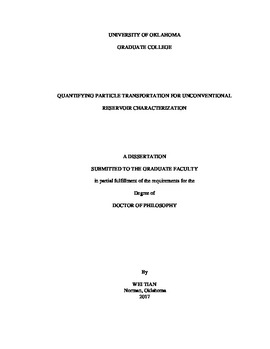| dc.contributor.advisor | Wu, Xingru | |
| dc.contributor.author | Tian, Wei | |
| dc.date.accessioned | 2017-10-24T13:37:22Z | |
| dc.date.available | 2017-10-24T13:37:22Z | |
| dc.date.issued | 2017-12 | |
| dc.identifier.uri | https://hdl.handle.net/11244/52392 | |
| dc.description.abstract | The objectives of this research dissertation include: (1) develop a novel procedure of single well chemical tracer test (SWCTT) and modification of method of moments (MoM) to estimate mobile oil saturation; (2) apply partitioning tracer to evaluate hydraulic fracture in unconventional reservoir; (3) develop a random walk particle tracking algorithm to simulate partitioning tracer transport in two-mobile-phase condition; (4) evaluate radon wellhead concentration associated with shale gas production to assess its danger to the public health.
A novel procedure of SWCTT is developed and method of moments is modified accordingly after investigating the movement of partitioning tracer. These modifications provide a simple and robust way to use SWCTT to estimate mobile oil saturation. Sensitivity analysis is also conducted to study the impacting reservoir properties that may affect result reliability.
Partitioning tracer is also introduced into the hydraulic fracture diagnosis. Partitioning tracer is proposed to be injected along with the fracking fluid and record tracer flow back data. Within one to two days’ production, sufficient tracer production data will be obtained to estimate fracture volume. Tracer selection criteria for this purpose are proposed.
A random walk particle tracking algorithm is developed to track the movement of partitioning tracer particles in the two-mobile-phase condition, which accounts for the contributions from advection and dispersion. Its result is compared with finite-difference based method, showing the advantage of less numerical dispersion.
Lastly, radon wellhead concentration from shale gas reservoir is estimated by integrating its generation, transport and decay process. Impacts of pore geometry and pore size distribution on radon in-situ concentration are investigated. Sensitivity analysis is also carried out to demonstrate which operation or stimulation parameters will affect radon production. The research outcome shows that the radon wellhead concentration can be above the safety level and it requires appropriate monitor and control.
Overall, this dissertation quantifies the particle movement in unconventional reservoirs. It studies particles’ transport properties, considering its dispersion, partitioning and reaction features. The ultimate goal of this dissertation is to provide an improved reservoir characterization. | en_US |
| dc.language | en_US | en_US |
| dc.subject | Fluid Transport | en_US |
| dc.subject | Reservoir Characterization | en_US |
| dc.subject | Tracer | en_US |
| dc.subject | Radon | en_US |
| dc.title | QUANTIFYING PARTICLE TRANSPORTATION FOR UNCONVENTIONAL RESERVOIR CHARACTERIZATION | en_US |
| dc.contributor.committeeMember | Harwell, Jeffrey H. | |
| dc.contributor.committeeMember | Shiau, Bor-Jier (Ben) | |
| dc.contributor.committeeMember | Jamili, Ahmad | |
| dc.contributor.committeeMember | Moghanloo, Rouzbeh | |
| dc.date.manuscript | 2017-10 | |
| dc.thesis.degree | Ph.D. | en_US |
| ou.group | Mewbourne College of Earth and Energy::Mewbourne School of Petroleum and Geological Engineering | en_US |
| shareok.orcid | 0000-0003-2877-3585 | en_US |
